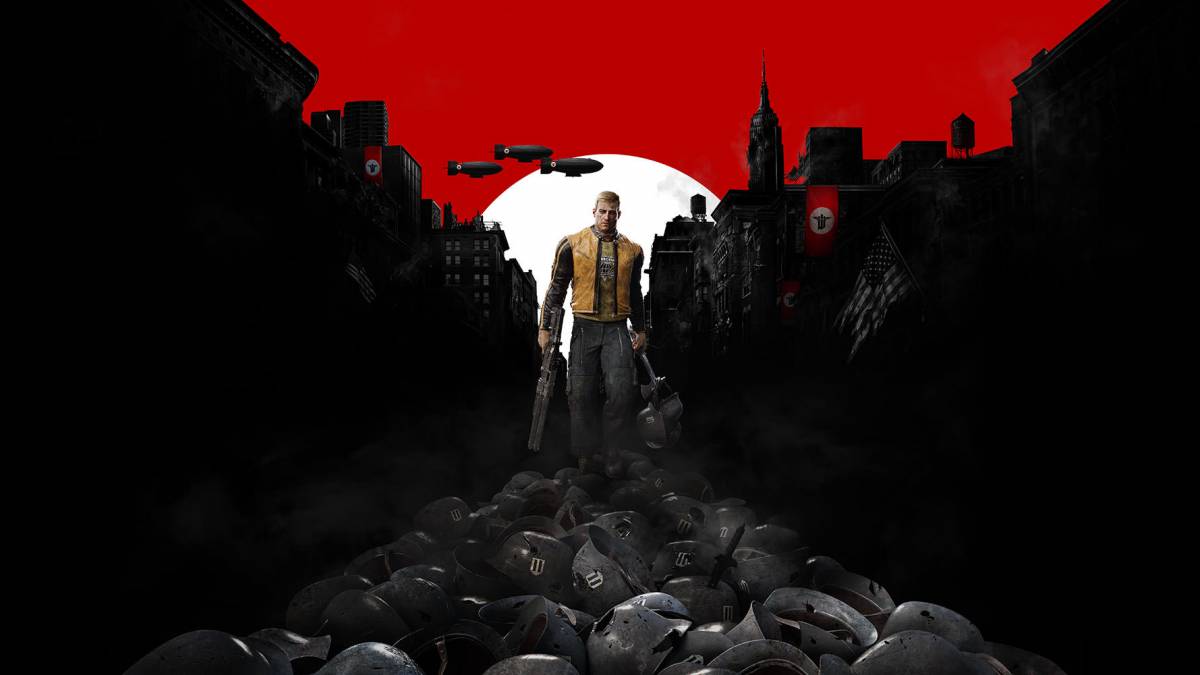If you played Wolfenstein: The New Order (which you really should), then you may remember the journal entries detailing a young woman’s covert war against the Nazis in her hometown. She goes into unflinching levels of graphic description of the violent and often intensely sexual nature of her seductions and subsequent murders of Nazi soldiers and officials, culminating in a rather stark reveal I won’t discuss here. It’s one of the many pieces of side content packed into the first game in MachineGames’ Wolfenstein series, and it has always stuck out to me as great chunk of character and world-building. Wolfenstein 2: The New Colossus takes this facet of the setting, a world under Nazi control, and turns it up to 11.
Picking up right where The New Order left off, Wolfenstein 2 finds BJ Blazkowicz beleaguered and broken, both physically and mentally, after the finale of the first game. Rescued by his friends and brought back to their captured U-boat HQ, he spends months in a coma before awakening to Nazis trying to recapture the submarine – and everyone on it. What follows is a memorable and darkly comedic jaunt around the submarine in a wheelchair, one hand on the wheel and one hand clutching a submachine gun.
This opening level gives way to the next taking a much darker turn, featuring a surprising, grisly and disturbing moment early on and the reestablishment of The New Order’s General Engel as the primary antagonist of the sequel. Together these two levels are a great primer for what to expect from The New Colossus – zany, inventive scenarios in which to kill Nazis and richly detailed and engrossing places to kill them in, with a mix of humor both light and dark offsetting some thematic and story content that gets quite dark and unsettling.
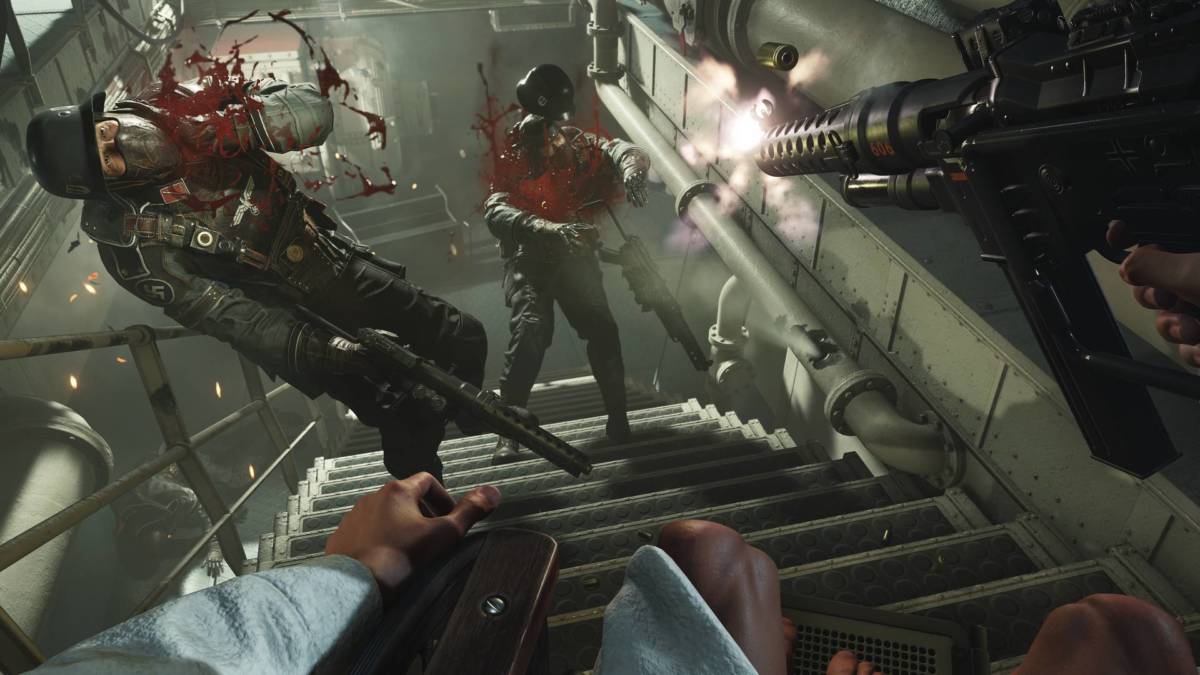
Wolfenstein 2 mostly succeeds in these areas, particularly in its characters, a healthy mix of returning faces like Anya, Set Roth and the lovable Max Hass to new faces in the American resistance and more. They are encountered in gameplay only in the U-boat hub, where you return between missions to complete small side quests on board and can also speak with or just listen to the characters interact. Between these interactions and the cutscenes and in-game cinematics, Wolfenstein 2 spends plenty of time with its characters, and they are almost all universally enjoyable to listen to and see in action.
More importantly, however, the characters contribute to Wolfenstein 2’s overall themes and setting of examining what a world under Nazi control might be like. Several major groups are represented among the game’s cast, including a host of nationalities, people of color, the mentally handicapped and even a German unwilling to participate in the doings of the Nazis despite being raised in their world, rejecting her indoctrination and siding with the resistance instead. On the other side of this, American society in this alternate timeline version of the 1960’s is not a wholly oppressed, reluctant place. While locations like an atomically-devastated Manhattan and a New Orleans ghetto in the midst of being cleansed of all inhabitants are suitably dystopian and grim, the most chilling thing about Wolfenstein is its insertion of Nazis into traditional Americana.
Typical 1960s American values and traditions are combined with white nationalism and supremacy at an institutional, wholly govermentally-enforced level in Wolfenstein 2’s America, and the game has no compunctions about showing homegrown racism and bigotry being the catalyst for collaboration and cooperation by Americans with their new overlords. KKK members joke and practice their German with Nazi soldiers amid July 4th celebrations not of American freedom, but Germany’s victory over the Allies. A mother discusses her pride at her son joining the ranks of the Wermacht with a friend, while another woman tries her best to kiss up to an officer by turning the bigotry dial up to 11. Letters and and newspapers in the environment paint a disturbing picture of normalization as Nazi Germany and America become one. Perhaps most effective is BJ’s own background involving his family that showcases just how unchecked bigotry and hatred can cause grave damage, even before the Nazi war machine and society figures into the picture.
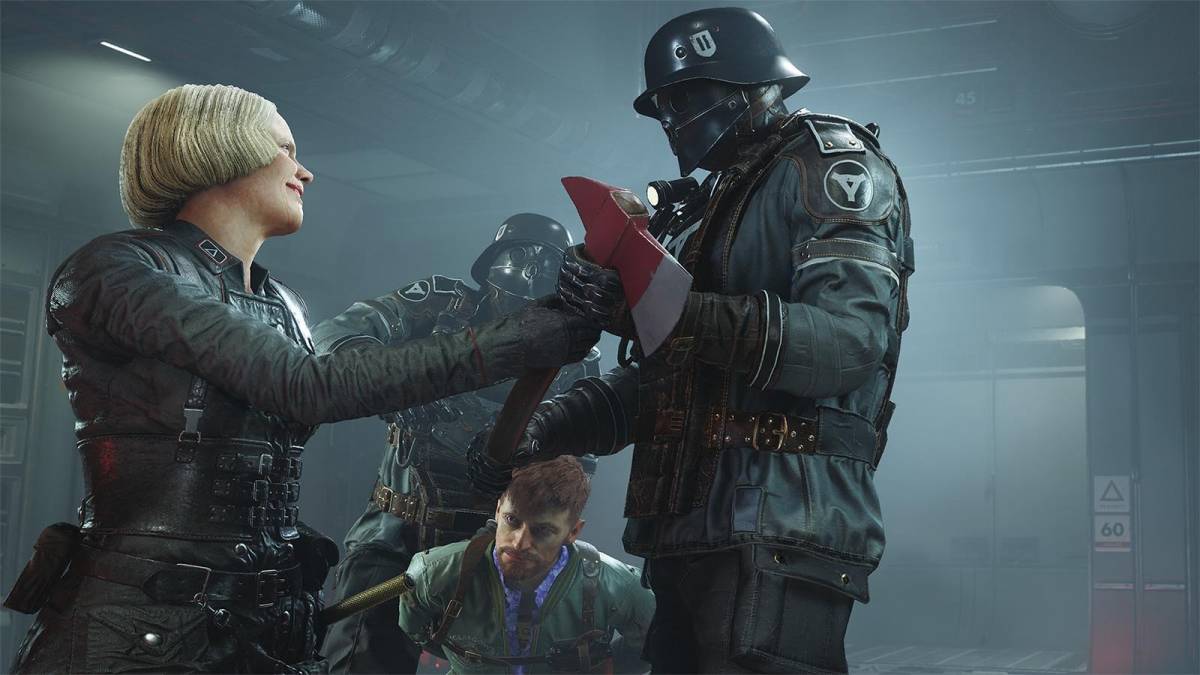
Despite the overall effectiveness Wolfenstein 2 displays at tackling its subject matter and building its setting, there are some hiccups. Cutscenes can occasionally drag on for far too long, and there are more than a few moments where humor either appears at a jarring and unnecessary moment or simply fails to hit the mark, resulting in some bizarre and abrupt tonal shifts that can ruin great character moments or story developments. Some characters get a bit irritating with their continual shtick – not everyone gets proper screentime to properly develop or at least endear themselves beyond their loudest attributes, and this can sometimes cause characters to seem one-note. No character major or minor is ruined by this, but it can at times make you anxious for the next level and take you out of the otherwise engrossing narrative.
As for said gameplay, the short of it is that it is very similar to The New Order, with the addition of the ability to dual-wield any two weapons in combination, the ability to upgrade them with rare upgrade kits and a couple of new perks and abilities. BJ now has a set of hatchets to use both for close-in executions reminiscent of DOOM’s Glory Kills (though in my opinion much more satisfying here due to the animations even if they don’t restore health) and as throwing weapons, replacing the knives from the previous game. Perks return as well, once again adding stat benefits to your ammo, health, armor, weapon power and more as you complete certain actions in gameplay such as dual-wielding kills, headshots, kills while overcharging your health, etc. This encourages experimentation while simultaneously rewarding any kind of playstyle – whether you prefer plinking with a rifle at the helmeted heads of Nazi soldiers, chopping at necks from the shadows with hatchets or running in like a madman with dual shotguns (seriously the shotgun is fucking awesome), the game will recognize and reward you, no skill point allocation needed.
With that being said, it is clear to me that Wolfenstein 2 was designed with action in mind. Much like The New Order, stealth is incentivized with the inclusion of Commanders, weak enemy officers who nonetheless hold the power of infinitely spawning hordes should anyone spot you while they are alive. The solution is to kill them before anyone spots you, or hunt them down during the alert phase. You can still evade enemies during an alert and they can lose track of you while you reorient for another attack, and the game never feels like it is outright punishing you for failing stealth, but the mechanics themselves are barebones – you get a suppressed pistol and the hatchets, but other than that you’re relegated to crouch-walking and peeking your way tediously through environments. Some areas feel impossible to stealth, especially ones stocked with heavy armor troops who cannot be stealth killed, and the only solution is to kill the commanders as quickly as possible before the infinite waves of troops whittle way your health and armor.
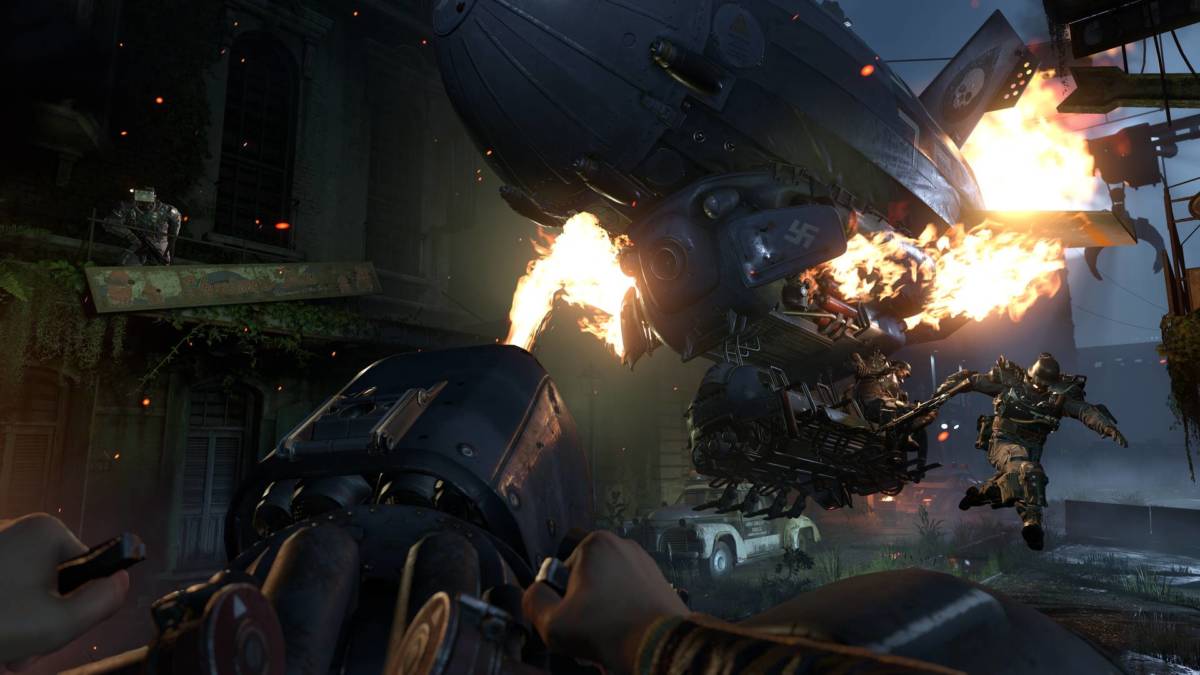
This brings me to my one major issues with Wolfenstein 2’s combat and mechanics. See, for the first half of the game, for admittedly justified reasons narratively, BJ’s health pool maxes out at 50, with the possibility of overcharging it to a max of 200 (which steadily degrades back to 50 by itself). You get more armor to offset this, but in practice it doesn’t mean much – on all but the easiest difficulties, it doesn’t take much fire to bring you down, even later in the game when you get your 100 maximum health back. This in and of itself is not a bad thing – players who want to survive will quickly find themselves remaining mobile in a fight, using the buttery smooth and precise aiming to maintain accurate fire and prioritizing targets while darting between cover and down various flanking routes. However, there are certain areas, especially ones where you’re forced to defend a position or fight a large enemy or set of enemies in a confined space, where this mobile mayhem isn’t as feasible.
Threats can come from all sides, and during alert phases I saw with my own eyes enemies appear from places they logically should not be able to, such as a hallway from an area I just cleared or where there isn’t even an entry way at all. This coupled with the lack of any sort of apparent hit indicator other than a soft thunk when you take a hit, and it is very easy to go from 200 health and full armor to blinking red in mere seconds without realizing. The distinct lack of damage feedback aside from when you are knocked down by an explosion or a charge attack really can be frustrating, as the quiet sound I mentioned is easily miss-able against the din of battle (and Mick Gordon’s wonderful soundtrack), resulting in some jabroni who pops out of a broom closet with a Maschinepistole chewing through your armor without you realizing until it’s too late. The chaos of combat in Wolfenstein 2 simply doesn’t feel quite as polished and enjoyable as something like DOOM or even The New Order.
With that said, everything else about shooting, stabbing and immolating Nazis in this game is fucking awesome. The weapons all have great impact both physically and audibly, though the pistol and SMG become fairly useless by midgame except for stealth and occasionally dual wielding if you run out of assault rifle ammo, respectively. Each normal handheld weapon has three upgrades. Some, like the scope and armor piercing rounds for the assault rifle and the ricochet for the shotgun, are essential – my go-to dual wielding pairing was the assault rifle with the scope switched on (which limits the gun to semiautomatic but makes it more accurate) and the shotgun. Nothing from close to medium range survived for more than a few seconds, not even the heavily armored Super Soldiers. Other upgrades are functional and usually helpful, but some are entirely skippable, especially secondary functions on early-game weapons that are inferior choices to upgrading weapons found later in the game.
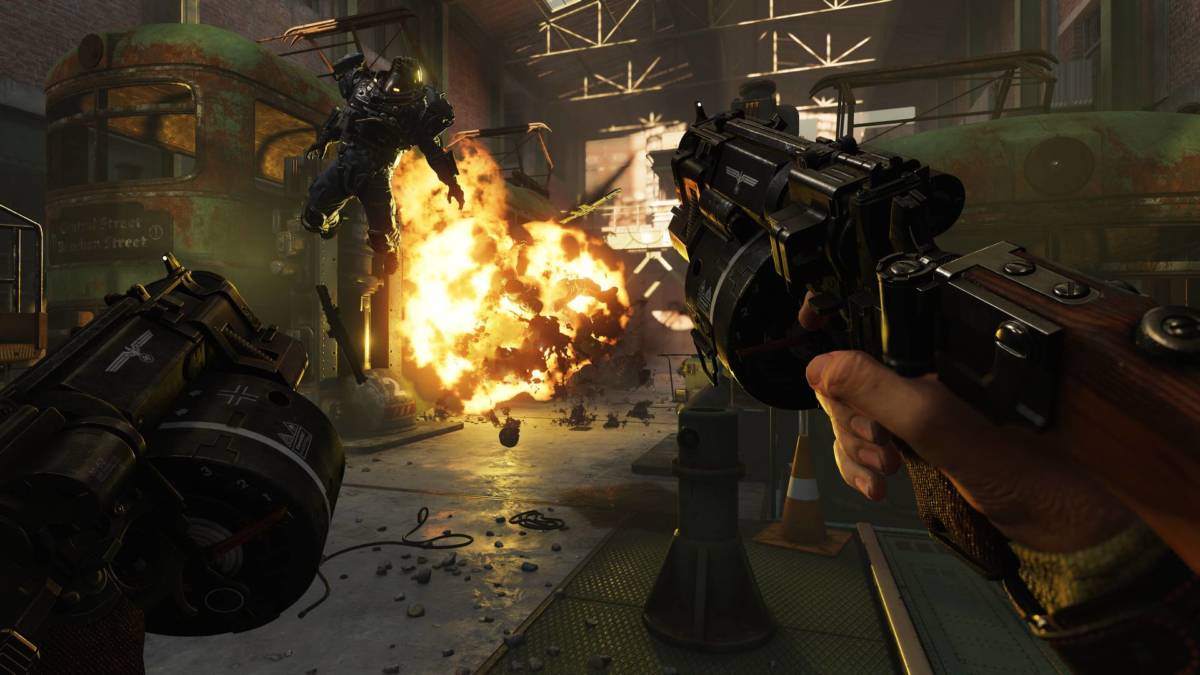
Mounted to tripods and the arms of the Super Soldiers are a variety of heavy weapons, which can be carried at the cost of movement speed and must be dropped to climb ladders or switch to other weapons. The most useful and cool of these heavy weapons is the Lasergewehr, which acts like the Laserkraftwerk (which returns in this game in the Fergus timeline) on steroids. Certain pieces of cover, supply crates and of course enemies can be melted by this visual and audio spectacle of a weapon, and I highly recommend picking one up whenever it is available to roast some Nazi scum. Others like the Diesel and Hammergewehr are less useful, at least to me – the Hammergewehr is basically a big burst-fire rifle/shotgun that isn’t very accurate even up close, and the Dieselgewehr functions more or less like the Dieselkraftwerk, the sticky bomb gun you get instead of the Laserkraftwerk in the Wyatt timeline which I beat the game on. The Ubergewehr, Wolfenstein 2’s “BFG,” is visually impressive but highly situational – even when it was available I found myself preferring my beloved shotguns to carve through a big crowd.
Regardless of your firearm of choice, the violence and gore in Wolfenstein 2 is visceral, heavy and glorious. Hatchet kills remove limbs and result in explosions of blood, armor bits mix with chunks of flesh and bone as shotgun pellets and assault rifle bullets tear apart enemy soldiers and ragdolled corpses and giblets rain down from environmental explosions and grenade kills. Super Soldiers and Panzerhunds often explode violently when destroyed given the ordinance needed to take them out. Even the simple crumple of a guard to the floor as you pop him in the head with the low-powered suppressed pistol, his helmet flipping off his dome as he goes has a certain satisfaction to it. Simply put, this game feels damn good when it has you doing what it does best – getting into fights with Nazis.
The average player can probably look forward to a good 10-12 hours of Nazi killing, depending on how quickly you find your rhythm and settle into a difficulty level you like. I stuck with “Bring ’em On” for most of the game, but I am not ashamed to admit that I eventually knocked it down to “Don’t Hurt Me” when a particular section got to be too much for me – it just feels better to be able to run around blasting away without having to worry about getting dropped in a handful of shots.

There’s some extra mileage in playing on higher difficulties, as well as doing all of the side missions to assassinate Nazi Commanders, which takes you back through areas of previous mission now repopulated with new enemy configurations and a more powerful commander variant to kill. Here you can find any collectibles you missed on your first run, as well as find upgrades for your “Contraptions,” three gadgets you gain access to over the latter half of the game that provide both new navigational options and new, fairly useful perks. You choose one to start, but can find the others on side missions. Couple the side content with the new storylines and cutscenes brought on by the timeline you don’t choose, and Wolfenstein 2 packs a pretty decent amount of content into a linear, single-player-only game.
Machine Games really has done something special here with Wolfenstein 2: The New Colossus, and their take on the series as a whole. They’ve taken a game that was fairly simple in concept but undeniably essential in video game history, and turned it into a fantastic modern shooter that is also one of the few games out there period that can say that it tackled some heavy, dark themes and (unintentionally) relevant political and societal issues, and did so successfully without trivializing or fumbling it.
In the tradition of another of my favorite studios, Arkane, Machine Games has crafted a rich, engrossing setting and history to back it up, and gone the extra mile by populating it with a cast of good-to-great characters and told a story that manages to be at once pulpy and entertaining while also being unafraid to tackle very real and grave topics. Then they give you a bunch of cool guns and gadgets and let you blow up everyone’s favorite villains.
By the look of this game’s ending, they’re not done yet. I can’t wait to see how they improve and evolve the series, and I most certainly can’t wait to keep up the fight to take back the world (and space) from the Nazis.
Review code provided by publisher
Some of the coverage you find on Cultured Vultures contains affiliate links, which provide us with small commissions based on purchases made from visiting our site.
